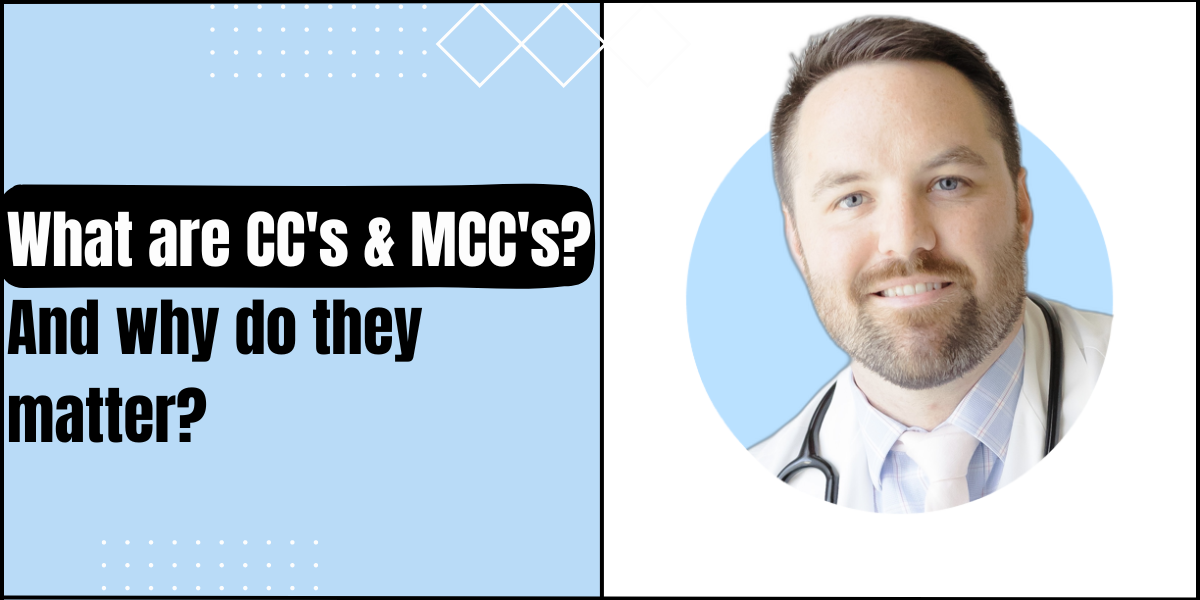DOD #5: What are CC’s and MCC’s? And why do they matter?
A big thank you to our sponsor who keeps this newsletter free for readers:
"Today's issue is brought to you by The Expert Witness Newsletter, a medical malpractice publication showing real expert witness opinions from real lawsuits. Check out this case involving 2 hospitalists who missed bacteremia, resulting in the patient's death."
Read time: 3 minutes.
You're told to add as many CC and MCC diagnoses as possible. But what do they mean. And why?
The modern American healthcare system is complex, and my newsletter will continue to unravel that system for you so you can understand it... so you can thrive in it... and possibly change it. More in Q/A.
First, what are they?
CC = Comorbid Condition
MCC = Major Comorbid Condition.
I know, still meaningless. Here’s why they matter: Many diagnoses have three tiers:
1. Diagnosis without CC/MCC
2. Diagnosis with CC
3. Diagnosis with MCC
The higher the tier, the higher the payment. Adding a CC and then an MCC adds “weight” to the diagnosis. What is “weight?” Let’s do some examples:
Sepsis may have a weight of 1.0. Adding AKI (a CC) will increase the weight to 1.28. However, adding ATN (an MCC) will raise the weight to 1.972!
Each hospital has a “multiplier” called the base payment rate (BPR). Here's an example:
If your hospital’s BPR is $6,000 and a diagnoses’ weight is 1.0 then the payment is $6,000 (6,000 x 1.0). If the diagnoses’ weight is 1.5 then the payment is $9,000 (6,000 x 1.5).
You may think: If you keep adding MCC’s the weight (and payment) gets higher and higher?! Unfortunately, No. So why add as many MCC's as possible? Because if you only have one MCC, insurances can find loopholes to deny that MCC diagnosis actually exists - saving them a lot of money by moving it down a tier.
They can...and they DO.
But if you have multiple MCC diagnoses, the likelihood of them successfully denying every MCC and moving the diagnosis down a tier is almost impossible. So, your hospital saves the money it used to take care of that medically complex patient. (Also increases your case mix index and improves RAMI... more below in Q/A)
In summary:
1. Adding CC and MCC diagnoses raises a diagnosis' tiers
2. Higher tier = higher payment
3. Insurances may remove a single MCC = dropping it down a tier
4. It's almost impossible for them to remove multiple MCC's and successfully move down a tier.
Question / Answer
First, a clarification:
I am a CDI Director. CDI = Clinical Documentation Integrity. I educate and encourage accurate and complete documentation to reflect the care of the patient. The result of accurate and complete documentation is often increased reimbursement / payment (because we're so bad at it otherwise). It is a motivating factor, but not the ONLY motivating factor. This issue is not about inappropriately adding new diagnoses, but accurately documenting the diagnoses that exist.
What is Case Mix Index?
Put simply, it is a numerical representation of how sick your patient population is. Among other things, this number is used by some insurance companies to determine how much they will pay your hospital. So, accurately capturing how sick your patients are THIS year will help reimbursement NEXT year.
Is this the same for Ambulatory Care?
No. The outpatient setting uses HCC's and you must "recapture" them every year. I will eventually have newsletter issues focused on the outpatient setting.
What is RAMI?
Risk Adjusted Mortality Index. This is a numerical representation of how many patients are dying in your hospital, or on your service line, compared to what is expected. Less than 1 is the goal. Greater than 1 means more people are dying in your hospital than expected. This is often a result of documentation rather than quality of care. I've seen RAMI scores for individual physicians (although it is an imperfect application in that situation). So, accurately documenting how sick your patient is = makes you, your service line (hospitalists, pulmonology, cardiology, etc) and your hospital look like you're giving the proper care that you are.
What does this have to do with me, and how does this help patient care?
This is a fantastic question - one that requires a proper, full answer. I will not even partially answer it here as it requires an entire newsletter issue in itself. Check out my article posted on LinkedIN on the topic: (3) Post | Feed | LinkedIn
Are physicians the ones making the denials at these insurance companies?
In the denial letters that I've seen, they're signed "Sincerely, X insurance company." There is no name nor credentials listed.
How does this work on admission? Am I supporting fraud if I "pick the worst diagnosis" or hindering revenue if I pick the "less bad" diagnosis?
The only diagnoses that matter are those that have not been ruled out by the time of discharge. So, it is okay to have a broad differential on admission and then clarify those diagnoses throughout the admission. Ideal language to use = "ruled in" or "ruled out."
January 21, 2023
About the newsletter
Every other Saturday morning, you’ll receive high-yield actionable tips to help your notes help you.
Search my newsletter issues:
Delivering high-yield actionable tips to help your notes help you
Join other subscribers who are transforming their notes into tools that work for them and their patients. Dr. Oubre’s Digest is released every other Saturday.
